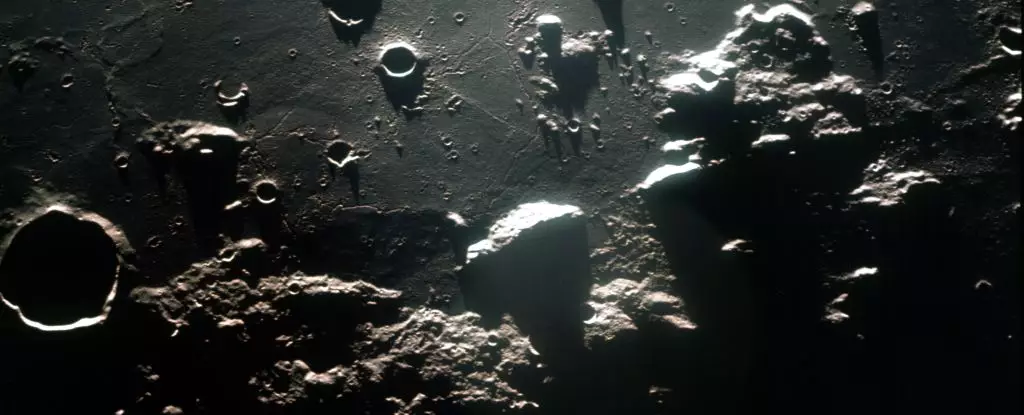The Moon, often viewed as a barren landscape, is increasingly revealing its secrets, particularly regarding the presence of water. Recent research has uncovered that water and hydroxyl—two compounds vital for understanding the Moon’s geology and potential for human exploration—exist in various locations across its surface. This revelation not only reshapes our perception of the Moon’s composition but also enhances the prospects for future lunar missions. The implications of these findings are profound and multifaceted, affecting both scientific inquiry and space exploration strategies.
While most images of the Moon evoke images of a dry, unwelcoming surface, these new insights suggest that water is more prevalent than previously recognized. The notion that liquid water is absent from the surface is accurate in a literal sense; there are no lakes or rivers. However, lunar research demonstrates that water molecules can be found within the soil and rocks, embedded in minerals, particularly in varying geographical settings on the Moon. Using advanced technology aboard the Chandrayaan-1 spacecraft, scientists have been able to map the distribution of water and hydroxyl, revealing their presence across all latitudes.
Roger Clark, a planetary scientist involved in the research, points out that these discoveries may overturn long-standing beliefs that water is predominantly confined to the polar regions. This has significant implications for future lunar exploration as it indicates astronauts may access water sources nearer to the equator. Understanding the mineralogical presence of these molecules is critical not only for supporting human life but also for piecing together the Moon’s geological narrative, thus enriching our knowledge of its evolution.
Previously, understanding the Moon’s water distribution primarily hinged on the assumption that it existed in ice form in shadowed craters located at high latitudes. While these areas indeed house ice deposits that could be several meters thick, the new research indicates that other regions also harbor water. Water, along with its companion molecule hydroxyl, is not exclusively a polar phenomenon; it is locked within minerals accessible throughout the Moon, a fact that can change how we plan for lunar missions.
The researchers utilized data collected from the Moon Mineralogy Mapper, which has provided invaluable spectral information about the Moon’s surface. Their analysis shows variations in the abundance of water and hydroxyl across different geological formations. Interestingly, while abundant in certain rock types, such as pyroxene, the concentration of water-rich materials diminishes in regions known as lunar maria, typically associated with ancient volcanic activity.
Furthermore, the presence of hydroxyl molecules—produced both by solar wind and cratering events—suggests a complex history of water dynamics on the lunar surface. This ongoing interaction highlights a dynamic geological environment, with cratering and volcanic processes continuously shaping the landscape.
Understanding the intricacies of water’s presence on the Moon is crucial for human habitation. Since water can be processed from the hydroxyl-laden minerals found on the surface, astronauts may have the capability to extract and utilize this resource for survival, alleviating some of the logistical challenges of transporting water from Earth. Future missions could take advantage of these insights, making the Moon a more viable candidate for long-term human presence in space.
The implications extend beyond mere survival; they suggest the Moon could advance as a base for further interplanetary exploration. Equipped with water, future lunar colonies have the potential to produce fuel for spacecrafts or other life-sustaining materials.
Additionally, this research may shed light on intriguing lunar phenomena such as the enigmatic lunar swirls—unique surface features characterized by their bright patterns. Initially, their formation mechanisms were a mystery, but the new findings suggest these swirls could be related to areas that are notably deficient in water. This correlation raises further questions about the Moon’s geological history and its magnetic properties.
The presence or absence of water in these swirls may indicate ancient geological processes that have left their mark on the Moon’s surface. Understanding such features is integral to painting a comprehensive picture of how the Moon has changed over billions of years.
The Moon is proving to be a far more interesting and complex world than previously thought. The discoveries of water and hydroxyl across its surface hold great promise for both scientific understanding and the practicalities of lunar exploration. As we prepare for the next waves of exploration, these insights will not only guide our understanding of the Moon’s past but also illuminate pathways toward a sustainable human presence on our nearest celestial neighbor. The Moon, once regarded as lifeless, now appears teeming with possibilities, paving the way for the next chapter in humanity’s journey into space.


Leave a Reply